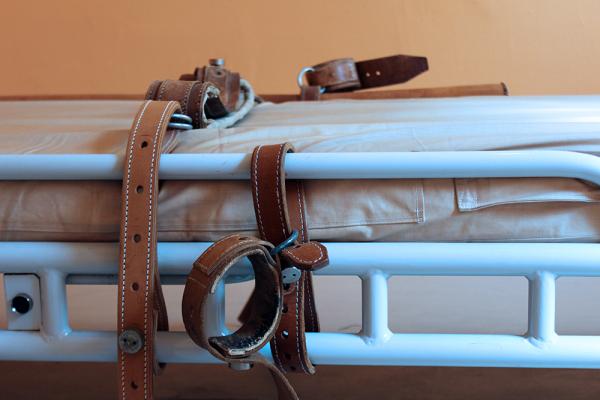
-- In response to a plague of allegations of child restraint abuse in behavioral facilities, a Utah senate committee has unanimously approved a bill to limit the use of restraints and isolation rooms and bans chemical restraints.[1] Mental health watchdog Citizens Commission on Human Rights International said it is one of several states taking action in the wake of restraint deaths and appalling abuse of troubled teens, often in behavioral facilities owned by for-profit psychiatric hospital chains. CCHR wants to see chemical and physical restraint use on youths universally banned.
The bill, which was introduced by Utah Senator Mike McKell, an attorney and Adjunct Professor, Utah Valley University, states that a congregate care program (defined as outdoor youth programs, residential support program, residential treatment program, or therapeutic school) may not use cruel, severe, unusual, or unnecessary practice on a child, and lists several examples that includes:
“inducing pain to obtain compliance, hyperextending joints, peer restraints, discipline or punishment that is intended to frighten or humiliate, spanking, hitting, shaking, or otherwise engaging in aggressive physical contact, and others.”[2]
Utah legislators were stunned by the abuses reported to them and Senator Mike Kennedy asked if they should ban troubled teen behavioral facilities outright.[3] Jan Eastgate, president of CCHR, agrees with Senator Kennedy because in the late 1990s, there was a similar outcry over troubled teens dying from restraints in psychiatric facilities, and despite reforms being implemented—“obviously they were insufficient, given the ongoing loss of children’s lives,” Eastgate said.[4]
A 1999 U.S. government report “found conclusively that children are especially targeted by facility staff for this unsafe practice (restraints), and are at greater risk of injury and death.”[5] African Americans have been over-represented in restraint-related deaths of children and adults with disabilities, accounting for 22% of the deaths studied while representing only 13% of the U.S. population.[6]
Meager penalties were introduced but were inadequate. The Federal Children’s Health Act of 2000 said that facility noncompliance with one or more Conditions of Participation regarding restraint and seclusion could lead to termination from the Medicare and Medicaid programs.[7] In 2008, Mother Jones found that “Despite thousands of reports of abuse in such programs—including torturous tactics like food deprivation, sleep deprivation, vicious and extended emotional attacks, sexual humiliation and punitive use of isolation and restraint—the programs have remained unregulated and have suffered few legal consequences.”[8]
“The necessity to use restraints in psychiatric-behavioral facilities should be considered treatment failure, and mental health agency oversight negligence,” Eastgate said.
Texas’s restraint law is one of the strongest for penalties. It allows a health and human services agency to “revoke, suspend, or refuse to renew the license, registration, or certification of a facility that violates” and “impose an administrative penalty against the facility” per violation and for each day of the violation.[9]
California’s law implemented a public reporting system for its state psychiatric hospitals that has been maintained since 2010. In January 2020, the average number of hours of restraint was 229 and for seclusion 304 hours—21 and 25 times greater than in 2018.[10] That should have flagged the need for an investigation. CCHR calls for a similar public report system in every state. The law says a drug cannot be used in order to control behavior or to restrict the person’s freedom of movement.[11]
If not yet banned, all restraint laws should include state and privately run psychiatric residential facilities, as restraint protections appear more stringent for schools. Students in California schools and special education were given added protections in 2018. Procedures that cannot be used include physical restraints that obstruct a pupil’s respiratory airway or impair the breathing or respiratory capacity and placing a pupil in a facedown position with the hands held or restrained behind the back.[12]
Eastgate said that restraint use on children and youths should be unconditionally prohibited. “It’s a disgrace that physical and chemical restraint assault of children in behavioral and psychiatric facilities/schools is not already eradicated.”
Since 2015, CCHR has filed thousands of letters with state legislators calling for reforms that include faster license and funding revocation and prosecution for any staff who carry out restraints that damage or kill patients and the psychiatrists or physicians that are required to order the restraints. See CCHR’s FightforKids Psychiatric Restraints Kill Children.
CCHR is responsible for more than 180 laws that protect patients from damaging psychiatric practices. DONATE to support its work https://www.cchrint.org/cchrint-donate/
[1] www.sltrib.com/news/2021/02/04/utah-troubled-teen/
[2] le.utah.gov/~2021/bills/static/SB0127.html, pp. 29-30, lines 884-905
[3] www.fox13now.com/news/local-news/paris-hilton-testifies-at-utah-state-legislature-on-troubled-teen-schools-bill
[4] ps.psychiatryonline.org/doi/full/10.1176/appi.ps.51.6.717
[5] journals.sagepub.com/doi/pdf/10.1177/070674370304800509; www.gao.gov/assets/230/228149.pdf
[6] www.cchrtaskforce.org/; www.equipforequality.org/wp-content/uploads/2014/04/National-Review-of-Restraint-Related-Deaths-of-Adults-and-Children-with-Disabilities-The-Lethal-Consequences-of-Restraint.pdf
[7] www.calhospital.org/sites/main/files/file-attachments/Preview_chapter_5_1.pdf
[8] www.motherjones.com/politics/2008/06/under-radar-child-abuse-bill-swap/
[9] capitol.texas.gov/tlodocs/79R/billtext/html/SB00325F.HTM
[10] www.dsh.ca.gov/Publications/Reports_and_Data/Seclusion_and_Restraint/docs/2020/1.pdf; www.dsh.ca.gov/Publications/Reports_and_Data/Seclusion_and_Restraint/docs/2019/1.pdf; www.dsh.ca.gov/Publications/Reports_and_Data/Seclusion_and_Restraint/docs/2018/1.pdf: During 2020 and COVID, the average number of hours of restraint was 229 in January and for seclusion over 304 hours compared to 2018, when seclusion hours for the same month was nearly 11 hours (21 times greater in 2020) and for restraints 12 hours (25 times greater).
[11] www.calhospital.org/sites/main/files/file-attachments/Preview_chapter_5_1.pdf, citing Health and Safety Code Section 1180.4(k); Title 9, California Code of Regulations, Section 865.4
[12] www.cde.ca.gov/nr/el/le/yr18ltr1224.asp
Release ID: 88997582

